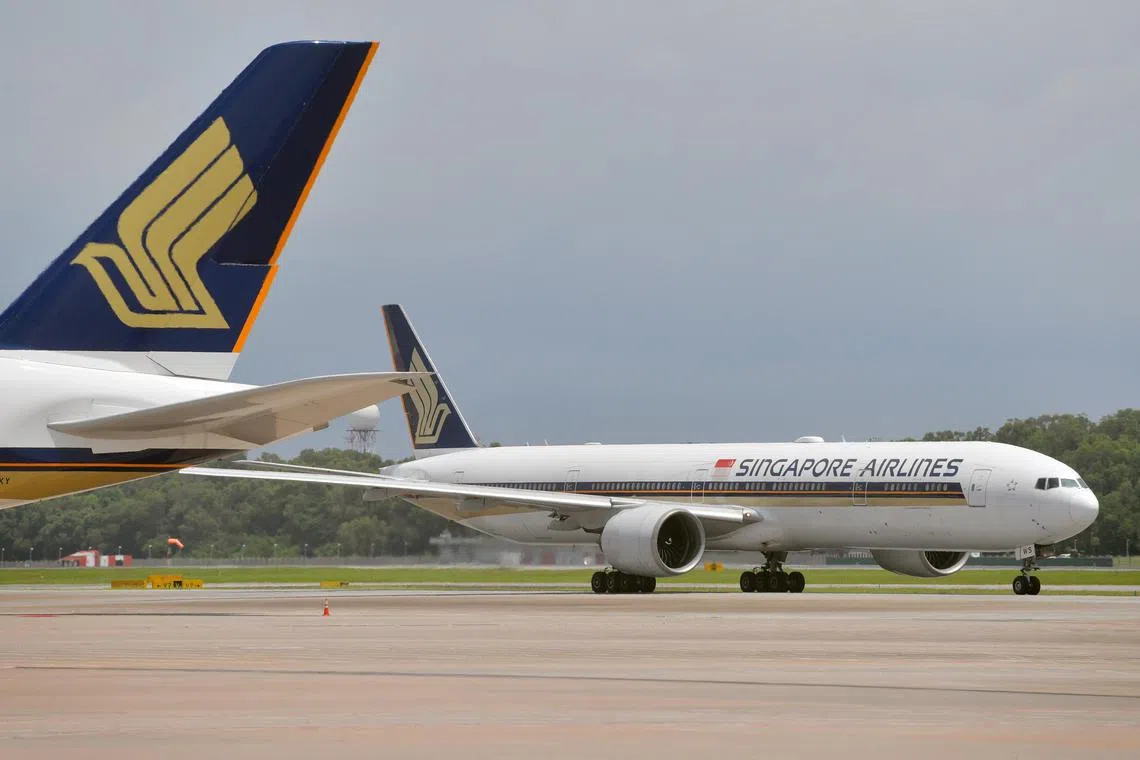SIA’s third-quarter profit soars to record $628m as passenger demand returns
Sign up now: Get ST's newsletters delivered to your inbox

SIA posted a net profit of $628 million for the third quarter of its financial year ending March 30, 2023.
ST PHOTO: ALPHONSUS CHERN
Follow topic:
SINGAPORE - Singapore Airlines (SIA) posted record profits in its latest business update, thanks to strong air travel demand and a reopening of international borders.
The airline group posted a net profit of $628 million for the third quarter of its financial year ending March 30, 2023, adding up to a record $1.56 billion net profit for the nine months between April and December 2022.
The figures were 12.7 per cent up from the previous year’s third-quarter profit of $557 million, and a reversal from the $752 million loss in the period from April to September 2021.
This came on the back of an 8 per cent year-on-year rise in third-quarter revenue to $4.85 billion, adding up to topline growth of 158 per cent to $13.26 billion for the nine months.
The company’s balance sheet remained strong.
As at Dec 31, 2022, the group’s shareholder equity was $19.4 billion, a reduction of $3 billion following a redemption of its June 2020 mandatory convertible bonds.
Total debt was up $4 billion to $16.1 billion, mainly due to sale and leaseback activity. The group’s debt-equity ratio rose from 0.7 times to 0.83 times.
Cash and bank balances rose from $1.6 billion to $15.4 billion. The group also retained access to $2.2 billion of committed lines of credit, but this has yet to be drawn.
All this came on the back of robust demand and record passenger load factors
As at Dec 31, SIA’s route network, which includes that of its low-cost airline Scoot, comprised 111 destinations in 36 countries and territories including Singapore, versus 137 destinations in 37 countries and territories before the pandemic.
The two carriers flew 7.4 million passengers in the third quarter, up 17 per cent from the second quarter. For the nine months ending December 2022, the group carried 18.8 million passengers, a ninefold rise from a year earlier.
During the October-December third quarter, the SIA Group reinstated services to destinations in China
Looking ahead, SIA said the momentum of passenger sales for the fourth quarter (January to March 2023) remains strong.
After posting load factors of well over 80 per cent during the third quarter, the airline reported a record 85.9 per cent load factor for January.
The big story for SIA will be China, one of its most important markets.
At present, SIA and Scoot serve 14 destinations in China, compared with 25 pre-pandemic. For the northern summer operating season (March 26 to Oct 28), Scoot will expand its services to China with flights to Haikou, Nanning, Ningbo, Shenyang and Xi’an resuming.
While the passenger side was robust, SIA Cargo’s performance moderated slightly due to softening demand, as well as an increase in bellyhold capacity as more passenger aircraft returned to service globally.
But while yields were weaker quarter on quarter, they remained elevated – almost double compared with pre-Covid-19 levels – the company revealed.
SIA has ordered seven A350Fs in an essential fleet replacement programme, and will be the first operator of this new-generation aircraft.
As at Dec 31, 2022, the SIA Group’s operating fleet comprised 188 passenger aircraft and seven freighters with an average age of six years and six months, versus around 15 years and seven months for the industry.
The biggest challenge the airline faces is rising fuel costs, which can compress profitability.
Elevated fuel prices are expected to persist in the months ahead, but this is an issue that will impact the entire airline industry.
The company said it has resumed its fuel hedging programme and is now hedged up to the end of the financial year ending March 30, 2024, “with additional gains locked in from closed-out trades”.
Net fuel cost during the third quarter rose 6.3 per cent to $1.33 billion, after a hedging gain of $196 million. For the nine months to end-December, net fuel cost fell 179 per cent year on year to $4.03 billion after hedging gains of $613 million.
Meanwhile, the company is focusing on its multi-hub and partnership/alliances strategy to stay ahead of the competition.
Last November, it announced that it had come to an agreement with Tata Sons to merge Air India and its 49 per cent-held Indian carrier Vistara.
SIA is also investing $360 million for a 25.1 per cent stake in the enlarged Air India. It said this would give it a strong foothold in one of the world’s fastest-growing and most populous markets, where air travel demand is rising by double-digit percentages annually.
The Vistara-Air India merger is expected to be completed in March 2024.
The airline is also forging ahead with collaborations with the likes of Virgin Australia, Air New Zealand, Malaysia Airlines, Scandinavian Airlines, United Airlines and others to offer enhanced connectivity and more options to customers, in addition to driving traffic to its hub.
It is also continuing to recruit and train staff to meet rising demand. SIA and Scoot are on track to hire around 3,000 cabin crew by end-March.
The stock closed unchanged at $5.78 on Tuesday.


